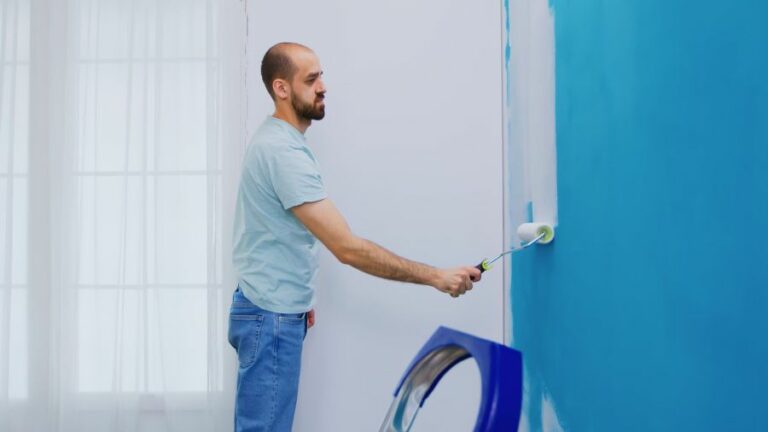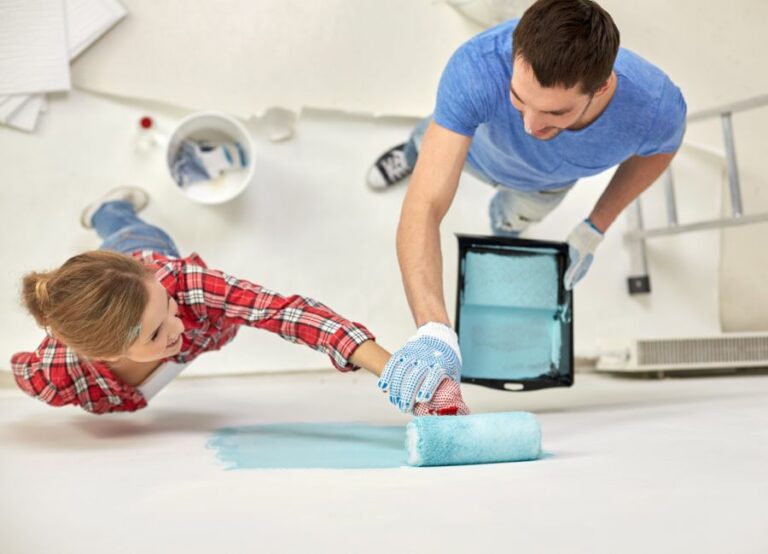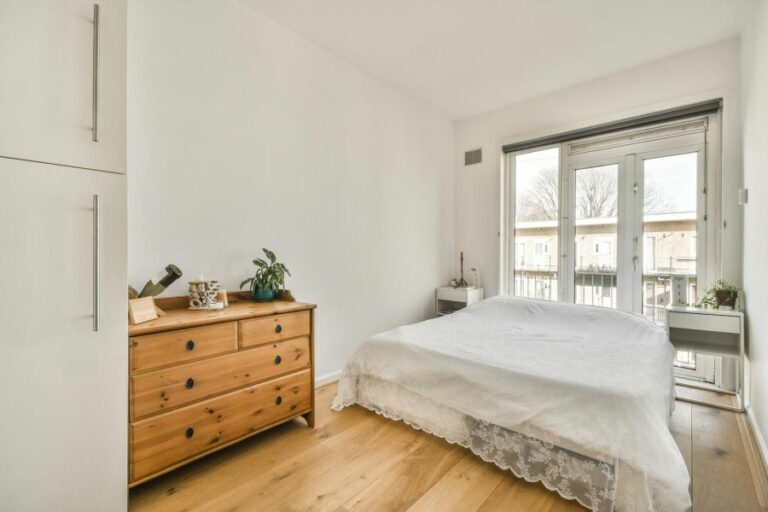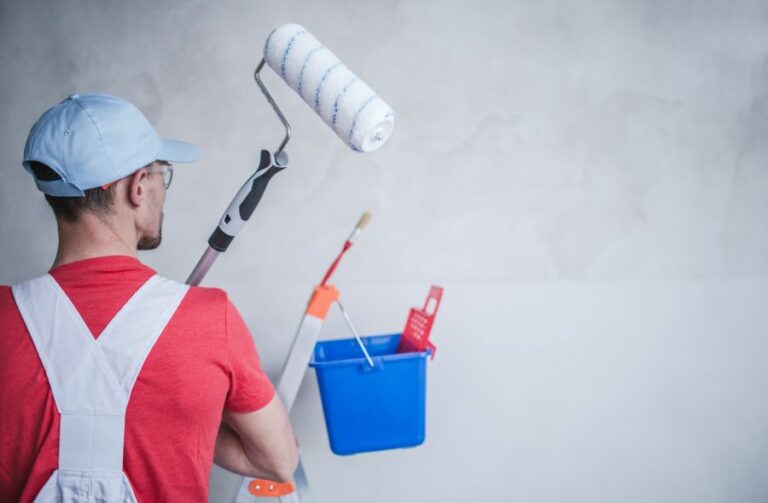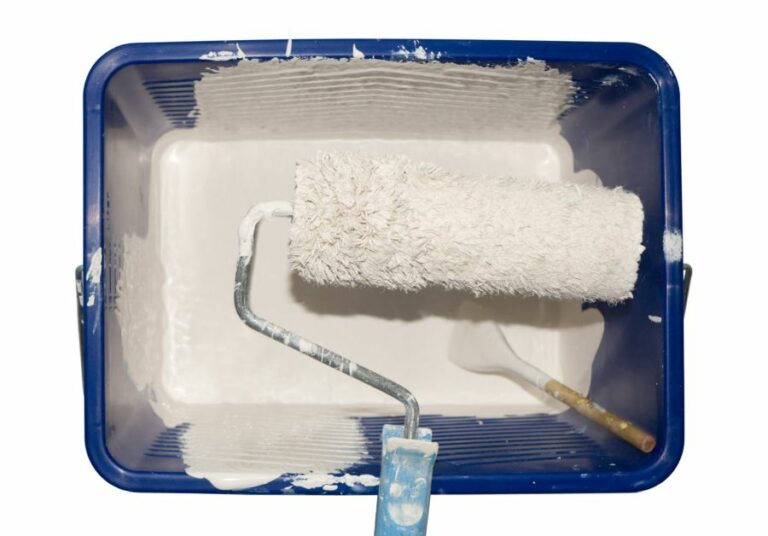Cost-Effective Indoor Painting Primer, 25 Things You Should Know
Are you looking to repaint your interior walls without breaking the bank? You’ve come to the right place! Choosing a cost-effective indoor painting primer is important to snatch those professional results without compromising the quality. After extensive research and testing, I have identified the perfect solution for your painting needs.
Cost-effective indoor painting primer:>
A cost-effective indoor painting primer is a latex primer, which offers rapid drying times, easy cleanup, and low VOC emissions. They provide excellent adhesion and durability on drywall, wood, and metal surfaces. Recommended latex primers include KILZ 2 Multi-Surface Stain Blocking Primer, Zinsser Bulls Eye 1-2-3 Primer, and Behr Premium Plus Interior Primer & Sealer.

Are you considering a new painting project and want it to look professional without breaking the bank? Then, look no further! Read on to discover cost-effective indoor painting primers that will give you stunning results without putting a dent in your wallet. Stay with me for insider tips and tricks!
Contents
- 1 Affordable Interior Paint Primer Options
- 2 Top-Rated Primers for Indoor Use
- 3 Importance of Primer for Indoor Painting
- 4 High-End Paint Primer: Is It Worth the Cost?
- 5 Top Primer Choices for Walls and Ceilings
- 6 Selecting the Perfect Primer for Interior Spaces
- 7 Best Kilz Primer for Interior Wall Applications
- 7.1 • Understanding Kilz Primer
- 7.2 • Kilz Original: The Go-To Primer for Most Projects
- 7.3 • Kilz Max: The Heavy-Duty Primer for Extreme Conditions
- 7.4 • Kilz 2: The Budget-Friendly Solution
- 7.5 • Kilz PVA: The Perfect Choice for New Drywall
- 7.6 • Kilz Restoration: The Solution for Odor Control
- 7.7 • Final Thoughts
Affordable Interior Paint Primer Options
• Why Primer Is Essential for a Successful Paint Job
A primer is an essential step in the painting process, as it prepares the surface for the paint and increases its durability. A correctly applied primer can significantly enhance the paint’s adherence, preventing premature peeling, blistering, or flaking.
Primers also help conceal earlier finishes or stains and improve the color and sheen of the topcoat. In short, using an appropriate and high-quality primer can make your paint job last longer and even save you money on additional layers of paint.
The Environmental Protection Agency (EPA) states that using a primer before painting can result in better adhesion and durability of the paint job.
• Choosing the Right Primer
Selecting the right type of primer for your project is crucial, as not all primers are the same. Broadly, primers fall into three categories: oil-based, latex, and shellac.
Each type of primer offers unique benefits and characteristics, but for indoor painting projects, the most cost-effective and versatile option is typically a latex primer.
This is because latex primers are water-based, making them easy to clean, faster to dry, and less rich in harmful volatile organic compounds (VOCs).
– Oil-Based Primer
Oil-based primers are one of the oldest and most popular types of primers available. They offer excellent adherence and are particularly useful for filling in wood grain and hiding stains on surfaces.
However, oil-based primers have a strong odor and release VOCs, which can be harmful to both humans and the environment. Many paint professionals prefer not to use oil-based primers for indoor projects.
– Latex Primer
Latex primers are water-based solutions that offer rapid drying times, easy cleanup, and intrinsic low-VOC emissions. These primers work well on a range of surfaces, such as drywall, woodwork, and masonry.
Moreover, latex primers provide excellent adhesion and durability while being relatively cost-effective. Many expert painters recommend latex primers for indoor painting jobs.
– Shellac Primer
Shellac primers have been around for centuries and are particularly effective at sealing wood knots and blocking stubborn stains. They dry quickly and offer excellent adhesion, but like oil-based primers, they come with a strong odor and release VOCs.
Shellac primers tend to also be more expensive than latex primers, making them a less cost-effective option for indoor painting projects.
• Factors to Consider When Choosing an Indoor Painting Primer
– Surface Material
The type of surface you are painting influences the primer you should choose. Latex primers are recommended for a range of surfaces, including drywall, wood, and metal, making them a versatile and cost-effective option for most indoor painting projects.
– Previous Paint
When covering a surface that has been previously painted, it is crucial to consider the existing paint type. Typically, latex primers can be applied over both oil-based and latex paint, making them more cost-effective than oil-based or shellac primers, which may require additional preparation or products.
– Stain Blocking
If the surface has stains or discoloration, choose a primer specifically designed to block stains. Although shellac primers are known for their stain-blocking abilities, some latex primers offer similar performance at a lower cost and with fewer drawbacks.
– Budget
When evaluating cost-effectiveness, consider not only the price of the primer itself but also the preparation and application costs, including cleanup and potential health risks. A latex primer generally wins in terms of affordability, user-friendliness, and readiness for use in various indoor settings.
• Recommended Latex Primers for Indoor Painting
Based on personal experience and industry research, the following are some cost-effective and high-performing latex primers for indoor projects:
- KILZ 2 Multi-Surface Stain Blocking Latex Primer: This water-based primer offers excellent adhesion and stain-blocking capabilities at a reasonable price.
- Zinsser Bulls Eye 1-2-3 Primer: This primer is known for its strong adhesion, quick-drying time, and suitability for a range of surfaces.
- Behr Premium Plus Interior Primer & Sealer: This product is a painter’s favorite for providing excellent coverage, hiding power, and a smooth finish.
By selecting a cost-effective primer and considering factors such as surface material, previous paint type, and stain-blocking requirements, you can ensure a successful and durable indoor paint job that will stand the test of time.
Top-Rated Primers for Indoor Use
Selecting the right primer is a crucial step when it comes to achieving professional-grade results for any indoor painting project. With a myriad of options in the market, it can be daunting to choose the ideal product.
• Understanding Different Types of Primers
Before diving into specific primer recommendations, it is essential to understand the various types of primers available and their distinctive qualities.
– Oil-Based Primers
Oil-based primers are a traditional choice, known for their excellent adhesion and stain-blocking properties. They are ideal for use on bare wood, unfinished surfaces, and walls that have water or smoke stains.
One notable drawback of oil-based primers is that they emit strong fumes, so it’s vital to ensure proper ventilation when working indoors.
– Latex-Based Primers
Latex-based primers are popular choices for indoor applications thanks to their minimal odor and quick-drying properties. These water-based products can be used on most surfaces, such as drywall, wood, and plaster. Generally, latex primers are not as effective at blocking stains as oil-based primers.
– Shellac-Based Primers
Shellac-based primers are renowned for their unparalleled stain-blocking abilities, particularly on surfaces affected by water, smoke, or nicotine damage. Despite their effectiveness, the strong odor and slow-drying time make shellac primers less common for indoor use.
• Ideal Primers for Different Surfaces
Now that we’ve explored the various types of primers, let’s examine which specific products are best suited for different surfaces found indoors.
– Primer for Drywall
When working with new, untreated drywall, a latex-based primer is the best choice. One of the most highly recommended products in this category is the KILZ Premium High-Hide Stain Blocking Interior/Exterior Latex Primer.
This fast-drying, low-odor primer is easy to work with and provides a smooth, even finish that is ready for painting.
– Primer for Wood
For bare wood surfaces, oil-based primers are the top choice due to their excellent sealing and adhesion properties. One standout product is the Zinsser Cover Stain Interior/Exterior Oil Primer Sealer.
This versatile primer can be used on a variety of wood surfaces, such as cabinets, trim, and doors, providing a durable, stain-blocking base coat.
– Primer for Stained Surfaces
When dealing with stubborn stains, a shellac-based primer is the best solution. The Zinsser B-I-N Shellac-Base Primer is an effective stain-blocking primer that provides a solid base for painting on surfaces with water, nicotine, or smoke damage.
Remember to ventilate the area well when using shellac-based primers, as the odor can be quite strong.
– Primer for Painted Surfaces
When repainting a previously painted surface, a latex primer works well. A top product in this category is the Benjamin Moore Fresh Start High Hiding Primer. This primer ensures an even, high-quality finish, regardless of the color or type of paint used previously.
• Final Recommendations
Ultimately, the best primer for your indoor painting project depends on the specific type of surface you are working with and the existing conditions. Here’s a recap of the top recommendations:
- Drywall: Opt for a high-quality latex primer, such as KILZ Premium High-Hide Stain Blocking Latex Primer.
- Wood: Choose an oil-based primer, like Zinsser Cover Stain Interior/Exterior Oil Primer Sealer, for superior adhesion and sealing.
- Stained Surfaces: Look for a shellac-based primer, such as Zinsser B-I-N Shellac-Base Primer, for unmatched stain-blocking capabilities.
- Painted Surfaces: Stick with a latex primer, like Benjamin Moore Fresh Start High Hiding Primer, for a smooth, even finish.
With these expert recommendations in hand, you’re well on your way to selecting the best primer for your indoor painting project. Happy painting!
Importance of Primer for Indoor Painting
A common question that many people have when it comes to painting the interior of their homes is whether or not they need to use a primer. The truth is, it really depends on the specific situation and the desired results.
• Understanding the Purpose of Primer
Before diving into whether or not primer is needed when painting indoors, let’s first understand its purpose. Primer is a preparatory coating specifically designed to adhere to surfaces and provide a uniform base for paint.
It ensures that the paint sticks well to the surface and allows for better coverage, durability, and longevity. It can also support a better finish and color by enhancing the properties of the paint.
Here is an informative article from the U.S. General Services Administration on the importance of using a primer in paint systems.
• Reasons to Use Primer When Painting Indoors
– Covering Stains and Imperfections
One of the primary reasons to use primer when painting the interior of a home is to cover up stains, marks, or any imperfections on the walls. Primer seals these imperfections and creates a smooth, even surface, allowing for a flawless paint job with fewer coats of paint.
– Changing Colors
If you are drastically changing the color of a room, primer can be incredibly helpful. It provides an opaque base that helps cover the existing color and ensures that the new color comes out evenly and true to its intended hue.
– Painting Over New Drywall or Unpainted Surfaces
New drywall or any unpainted surfaces tend to be porous and will absorb the paint at different rates. Applying a primer will help even out the porosity and provide a consistent base for the paint, ensuring a better finish.
– Adhesion on Glossy Surfaces or Difficult Materials
When painting over glossy surfaces or materials that tend to be difficult for paint to adhere to, such as oil-based paints or laminates, a primer can help ensure that the new paint bonds properly. Consider using a bonding primer specifically designed for these challenging surfaces.
• When You Might Not Need Primer
– Painting Over Light Colors
If you are painting a light color over a similar or lighter color, a primer might not be necessary. The existing color may not significantly impact the new color, and a simple clean and light sanding of the surface may suffice before applying the new paint.
– Same Color or Slightly Darker
When repainting a room in the same color or a color slightly darker, a primer may not be needed. Again, lightly sanding the surface and ensuring it is clean before applying the new paint can lead to a great finish without the need for primer.
– Paint and Primer in One
Many paint manufacturers now offer paint and primer combinations that can save time and effort in certain situations. These products have primer properties already mixed in the paint and can be useful when painting relatively even surfaces without major imperfections or dramatic color changes.
• Important Tips for Using Primer
If you have determined that using a primer is the best option for your painting project, here are some tips to ensure success:
- Choose the Right Primer: Selecting a primer specifically designed for your type of surface or situation (e.g., stain-blocking, bonding, or drywall) will ensure the best results. Consult with your local paint store professionals for guidance.
- Apply Evenly: Make sure to apply the primer evenly and allow it to dry fully before applying the paint. The drying time may vary depending on the primer’s formulation and environmental factors, so refer to the manufacturer’s instructions for specific drying times.
- Sand the Surface: In some cases, primers may leave a slightly rough surface once dry. Lightly sanding the surface with fine-grit sandpaper will provide a smoother, more even base for the paint.
- Clean the Surface: Before applying primer or paint, ensure the surface is clean and free from dust, dirt, or grease to ensure proper adhesion.
In conclusion, whether or not to use primer when painting indoors really comes down to the specific circumstances of your project. Understand the purpose of the primer, assess the surface conditions, and choose the right primer if necessary to achieve professional-looking, long-lasting results.
Case | Recommendation |
|---|---|
Painting over a darker color | Use primer |
Painting over stained or damaged surfaces | Use primer |
Painting over new drywall | Use primer |
Painting over finished wood | Use primer |
Painting over an existing paint with good adhesion | Primer is not always necessary |
Painting over an existing paint with similar color and finish | Primer is not always necessary |
High-End Paint Primer: Is It Worth the Cost?
When it comes to painting projects, whether it’s a room in your house or a piece of furniture, using a high-quality paint primer is often viewed as an essential step. The age-old question remains: is expensive paint primer worth the extra cost?
• The Benefits of Using a High-Quality Paint Primer
When investing in an expensive paint primer, there are several benefits that may justify the higher cost.
– Enhanced Adhesion
High-quality primers create an optimal surface for the paint to adhere to, ensuring a longer-lasting finish.
An article by the Painting and Decorating Contractors of America (PDCA), The Role of Primers in a Finished Paint Job, explains that primers provide a consistent base, enabling smoother paint application and reducing the likelihood of peeling or chipping.
– Superior Coverage
Investing in a more expensive paint primer will lead to a smoother and more even coverage, resulting in less paint and fewer coats needed. This means that while you may be paying more upfront for the primer, you could save money on paint costs in the long run.
– Better Resilience
High-quality primers offer greater resistance to moisture, stains, and mildew. According to the EPA, moisture, and mold can cause numerous health issues, making it crucial to control moisture in your home.
By using a high-quality primer, you create a stronger barrier to protect against these potential problems.
• The Risks of Using a Cheap Paint Primer
Opting for a cheaper paint primer may seem like a way to save money, but it’s essential to consider the potential risks associated with lower-quality primers.
– Less Adhesion
One of the key functions of primer is to promote adhesion between the surface and the paint. Using a cheap primer may not provide adequate adhesion, leading to paint peeling or chipping over time. This means that you may find yourself repainting more frequently, negating any initial cost savings.
– Inconsistent Coverage
Cheap primers may not provide an even, solid base for the paint, leading to patches or uneven coverage. This results in using more paint to achieve a satisfactory finish and may require additional coats, incurring further expenses.
– Poor Protection
Low-quality primers may not offer the same levels of moisture and stain resistance as higher-quality options, leaving your paint job more vulnerable to damage from moisture, mildew, and stains. This could mean more frequent repainting or the need for more extensive repairs in the future.
• Personal Experience and Recommendations
As a painting professional, I have worked with a variety of paint primers across numerous projects. Based on my personal experience, I recommend investing in a high-quality paint primer when handling projects that require a long-lasting and flawless finish.
High-quality primers, such as Benjamin Moore’s Fresh Start or Sherwin-Williams’ Multi-Purpose Latex Primer, have consistently demonstrated superior adhesion, coverage, and protection throughout many different projects.
While the initial cost may be higher, the long-term benefits and potential cost savings make expensive paint primer worth it, in my opinion.
However, for small projects or those with a temporary nature, a more affordable primer may be adequate. Just be aware that cheap primers may not provide the same level of quality, and in certain circumstances, choosing a low-cost primer could require more work and expense in the long run.
• In Conclusion
Ultimately, deciding whether or not expensive paint primer is worth it should be determined by assessing the importance of a long-lasting and high-quality finish for your project.
By understanding the benefits of high-quality primers and the risks of choosing a cheaper primer, you can make an informed decision based on your specific needs.
Keep in mind that while the initial investment may be higher, the benefits, such as enhanced adhesion, superior coverage, and better resilience, make it a worthwhile consideration for any painting project where quality and longevity are top priorities.
Top Primer Choices for Walls and Ceilings
A well-painted room can immediately uplift the aesthetics and atmosphere of the space. Achieving the perfect painting job largely depends on the right choice of primer, a crucial first step in the process.
• Why Choosing the Right Primer Matters
Primers are essential in preparing the surface for a smooth, even, and long-lasting paint job. They enhance paint adhesion, ensure color uniformity, and prevent issues such as peeling and blistering. Different surfaces and conditions demand specific primers, making it crucial to choose the right one.
• Best Primers for Ceilings
Ceilings often suffer from issues such as water stains, mildew, and smoke stains. Let’s explore the top primers for tackling these problems effectively.
1. Stain-Blocking Primers
Stain-blocking primers are highly recommended for covering water stains, which are a common issue on ceilings. These primers are often oil-based, providing better stain coverage compared to their water-based counterparts.
I highly recommend using primers such as KILZ Original Multi-Surface Stain Blocking Primer for covering water stains effectively.
2. Mold and Mildew Resistant Primers
Mold and mildew can be a significant problem in humid areas and can negatively impact the health of the occupants. Mold and mildew-resistant primers are made with anti-microbial additives that inhibit the growth of mold and mildew on the surface.
Zinsser Mold Killing Primer, a water-based primer, is an excellent choice for areas prone to mold and mildew.
3. Smoke and Odor Blocking Primers
If the room has been exposed to cigarette smoke or has lingering odors, it’s essential to use primers specifically designed to block such smells. These primers typically have a very low odor and higher adhesion properties to seal off the stains effectively.
KILZ Restoration Maximum Stain and Odor Blocking Primer is a top choice for eliminating persistent odors and smoke stains from the ceiling.
• Best Primers for Walls
The condition, material, and texture of the walls can greatly impact the choice of primers. Here are some excellent options for different wall surfaces.
1. Drywall Primers
New drywall surfaces can absorb paint quickly, leading to an uneven finish. A drywall primer seals the porous surface, ensuring better adhesion and uniform paint coverage. Using a drywall-specific primer can also help in reducing the number of paint coats required for a uniform finish.
Glidden PVA Drywall Primer is an effective and affordable option for new drywall surfaces.
2. Masonry Primers
Masonry walls, including brick and concrete, can be challenging to paint due to their porous nature and unique texture. Masonry primers help in sealing the surface, increase paint adhesion, and reduce the number of required paint coats.
I recommend using Behr Premium Concrete & Masonry Bonding Primer for masonry walls.
3. Peel-Resistant Primers
For walls with peeling or flaking paint, it’s crucial to choose a primer that can bind the loose paint edges and provide strong adhesion for the new paint.
Zinsser Peel Stop Triple-Thick Primer is an excellent choice for fixing peeling issues on walls.
4. High-Hide Primers
High-hide primers are suitable for walls with challenging colors or patterns that need better coverage to ensure a uniform finish.
Benjamin Moore Fresh Start High-Hiding Primer is an excellent high-hide primer option.
• Selecting Low-VOC Primers
Traditional primers can emit harmful volatile organic compounds (VOCs). In recent times, many low-VOC and zero-VOC alternatives have been developed. When choosing a primer, it’s essential to consider the health and environmental impacts.
Refer to the Environmental Protection Agency Guide on Understanding Indoor Air Quality to gain more insight into the issue and the importance of using low-VOC products.
• Conclusion
Choosing the right primer is critical for ensuring a flawless and long-lasting paint job. Always take into account the specific conditions and requirements of the surfaces to be painted.
And while preferences and needs may vary, considering the options discussed in this article will provide a solid starting point for your next painting project.
Product Name | Type | Pros | Cons |
|---|---|---|---|
KILZ Original Interior Oil-Based Primer | Oil-based | Great adhesion, seals stains, covers odors | Strong odor, slow drying, requires mineral spirits for cleanup |
Zinsser 1-2-3 Water-Based Primer | Water-based | Low odor, fast drying, cleans up with water | Not as effective on glossy surfaces |
Zinsser BIN Shellac-Based Primer | Shellac-based | Unbeatable stain blocking, seals odors, dries fast | High fumes, requires denatured alcohol for cleanup |
Behr Drywall Primer & Sealer | Water-based | Good adhesion to drywall, low odor, fast-drying | Not as effective on other surfaces |
Rust-Oleum Zinsser Bulls Eye 1-2-3 Primer | Water-based | Low odor, great adhesion, fast-drying | Less effective for severe stains and odors |
Selecting the Perfect Primer for Interior Spaces
Selecting the perfect interior paint primer is key to achieving a successful paint job. The right primer sets the foundation for a smooth, durable, and long-lasting finish.
• Types of Interior Paint Primers
Before diving into the specific factors that should influence your selection, it is important to understand the four main types of interior paint primers:
- Latex primer: water-based and easy to clean, it is ideal for most surfaces.
- Oil-based primer: excellent adhesion and stain blocking but comes with a strong odor.
- Shellac primer: the perfect choice for sealing out tough stains and odors.
- All-in-one paint and primer: a time-saving option that combines both paint and primer in one can.
– Latex Primer
Latex primer is an excellent choice for most interior projects due to its versatility, ease of use, and low odor. It can be applied to a variety of surfaces, including drywall, plaster, and even masonry. As a water-based primer, it dries quickly, and cleanup is a breeze with soap and water.
I recommend using latex primer for most interior projects, as it provides a strong base for topcoats and generally results in a smooth, even finish.
– Oil-Based Primer
Oil-based primer is best known for its fantastic adhesion and stain-blocking capabilities. It’s especially useful when painting over surfaces with stains or dealing with materials like unsealed wood. However, this type of primer does come with a strong odor and requires paint thinner for cleanup.
I recommend using oil-based primer for projects that require heavy-duty stain blocking but be prepared to ventilate the area well and allow for longer dry times.
– Shellac Primer
Shellac primer is the heavy-duty option for sealing out the toughest stains and odors. It’s perfect for dealing with water damage, smoke damage, or other challenging issues.
Keep in mind that shellac primer can be more difficult to work with, as it dries extremely quickly and requires denatured alcohol for cleanup.
I recommend using shellac primer for specialized situations where severe stains or odors must be addressed.
– All-in-One Paint and Primer
All-in-one paint and primer is a popular choice for those looking to save time and simplify their painting projects. Combining the benefits of paint and primer in a single can offer convenience but may not offer the same level of performance as a separate primer.
I recommend all-in-one paint and primer for smaller projects and touch-ups, but for larger jobs or surfaces with significant imperfections, a dedicated primer is a better option.
• Factors to Consider When Choosing an Interior Paint Primer
– Surface Material
Different primers are designed to work with various surface materials. Always consider the type of material you will be priming, whether it’s drywall, wood, or masonry. Check the primer label to ensure it’s compatible with your specific surface.
– Surface Condition
Evaluate the condition of the surface you will be painting. Are there any stains, uneven textures, or other imperfections? Certain primers are designed to address these issues, such as oil-based primers for stain-blocking or primers labeled as “high build” for smoothing out rough surfaces.
– Odor and Cleanup
Consider your tolerance for paint fumes and your preferred method of cleanup. Latex primers offer lower odor and easier cleanup with soap and water, while oil-based and shellac primers have stronger smells and require solvents for cleanup.
– Dry Time
If time is of the essence, choose a primer with a fast drying time. Latex and shellac primers tend to dry more quickly, while oil-based primers require longer drying periods.
– Compatibility with Topcoat
Ensure that your chosen primer is compatible with the type of paint you plan to apply as your topcoat. Most primers work with both latex and oil-based paints, but always confirm by checking the label.
• Expert Recommendations
Having looked at the types of interior paint primer and the factors to consider when making your selection, here are my expert recommendations:
- For most interior projects, a latex primer is the top choice due to its versatility, low odor, and easy cleanup.
- Use an oil-based primer for heavy-duty stain blocking or when painting over unsealed wood.
- Opt for a shellac primer when dealing with severe stains or odors.
- Consider all-in-one paint and primer for small touch-ups, but use a dedicated primer for more significant projects or surfaces with imperfections.
By following these recommendations and considering the factors outlined in this article, you will be well on your way to selecting the perfect interior paint primer for your next project.
For additional guidance from professionals in the field, visit The Painting and Decorating Contractors of America to find resources and advice from experts.
Best Kilz Primer for Interior Wall Applications
Over the years, Kilz has emerged as one of the top choices when it comes to choosing a high-quality primer for interior walls. Their range of products covers various needs, including sealing, blocking stains and odors, and creating a smooth canvas for paint.
With several options available, deeming which is the best Kilz primer for interior walls generally depends on your specific requirements.
• Understanding Kilz Primer
Kilz is a subsidiary brand of Masterchem, offering high-quality and versatile primer options according to the Environmental Protection Agency (EPA). Before diving into the options, understanding the benefits of using a Kilz primer is vital. These benefits include:
- Superior adhesion: Kilz primers provide an excellent base for paint, ensuring long-lasting results.
- Odor and stain blocking: Kilz primers are known for their ability to cover and seal stubborn stains and odors effectively.
- Mold and mildew resistance: Some Kilz primers are formulated to resist mold and mildew, promoting a healthy living environment.
- Smooth finish: Kilz primers create a consistent surface for paint application, resulting in a professional and even finish.
• Kilz Original: The Go-To Primer for Most Projects
When it comes to general interior use, the Kilz Original is often considered the best option. This oil-based primer provides excellent adhesion to various surfaces, including wood, drywall, and plaster.
Its stain-blocking properties ensure that any existing stains, from water damage to smoke, are effectively covered.
Additionally, Kilz Original effectively blocks odors from tobacco, pets, and fires, creating a clean slate for your new paint.
Recommendation: For most interior wall projects, I would recommend using Kilz Original as it offers unparalleled adhesion, stain blocking, and odor-sealing properties.
• Kilz Max: The Heavy-Duty Primer for Extreme Conditions
In cases where walls have experienced extreme damage or heavy staining, Kilz Max is the ideal choice. This water-based primer has been developed to address challenging situations, including stubborn water damage, heavy smoke, and nicotine stains. It also excels at sealing persistent pet odors.
Kilz Max is formulated with a mildewcide, which protects against mold and mildew growth on the primer layer.
Recommendation: If you are dealing with extreme staining, heavy odors, or mold and mildew concerns, I recommend using Kilz Max for optimum results.
• Kilz 2: The Budget-Friendly Solution
For those seeking a more cost-effective option without compromising quality, Kilz 2 is the perfect choice. This water-based primer is designed for easy application and adheres well to surfaces like concrete, masonry, and drywall.
While not as robust as other options, Kilz 2 still delivers excellent adhesion, stain blocking, and a smooth surface for paint.
Recommendation: For budget-conscious projects that do not require heavy-duty priming, I would recommend Kilz 2 as an affordable and reliable solution.
• Kilz PVA: The Perfect Choice for New Drywall
For new drywall installations, Kilz PVA is the best solution. PVA (polyvinyl acetate) is specifically designed to seal porous surfaces and create a smooth, consistent finish. Its water-based formula ensures low odor and effortless application. Kilz PVA dries quickly, allowing for painting shortly after application.
Recommendation: If you are working with new, unpainted drywall, I recommend selecting Kilz PVA for a smooth and even finish.
• Kilz Restoration: The Solution for Odor Control
If odor control is your primary concern, Kilz Restoration is the ideal option. This water-based primer is specifically designed to tackle challenging odors, including pet urine, smoke, and fire damage.
Kilz Restoration delivers excellent adhesion and stain blocking while also sealing stubborn odors and providing a fresh canvas for paint.
Recommendation: For projects where odor control is of utmost importance, I recommend using Kilz Restoration to eliminate unpleasant smells effectively.
• Final Thoughts
Selecting the best Kilz primer for your interior walls ultimately comes down to your project’s specific needs. Each Kilz primer provides unique features and benefits, allowing you to choose the ideal product for your situation.
By considering factors such as surface preparation, staining, odor control, and budget, you can confidently decide on the perfect Kilz primer to achieve professional, long-lasting results.
Product Name | Description | Key Features |
|---|---|---|
KILZ 2 LATEX | A water-based multi-surface primer, sealer, and stain-blocker | |
KILZ Premium | A high-quality water-based primer, sealer, and stain-blocker | |
KILZ Restoration | A water-based primer, sealer, and odor-sealer | |
KILZ Original | An oil-based interior primer, sealer, and stain blocker |

